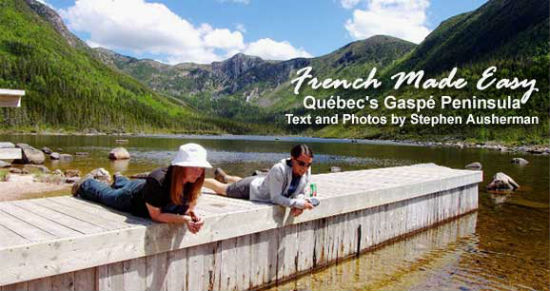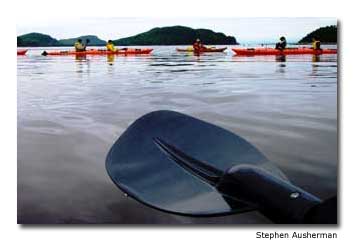

It’s no longer fair to refer to Québec as the “poor man’s French vacation.” True, it’s still cheaper than France, but it has a lot to offer. The province of Québec is enormous, more than three times the size of France, and much of the land is wild and untamed. Some of the best spots, like the Gaspé Peninsula — a tongue of land in eastern Québec between Chaleur Bay and the estuary of the St. Lawrence River — remain relatively unknown.
The Gaspé, “land’s end” in the language of the aboriginal Micmac people, is about 150 miles (240 km) long and 90 miles (145 km) broad at its widest spot. Its backbone, an extension of the Appalachians known as the Chic-Chocs, is a land of rugged mountains; Mont Jacques-Cartier (4,160 feet / 1,268 m) is the highest elevation in southeastern Canada.
“People are just waking up to the extraordinary beauty of Gaspé mountains and sea,” noted Gordon Brinley in her 1935 budget travel guide, Away to the Gaspé. She described a celestial land of country churches and covered bridges, and the friendliest gestures at every turn.
Seventy years later, her observations still hold true.
There is much to see here. Brinley afforded herself 90 days for her offbeat Gaspésian adventure. My travel companions and I had just seven, so we planned them wisely. Here are the highlights:
Bic National Park
The population of la Gaspésie is primarily francophone today. Jean-François struggles with his English to convince us that his kayak expeditions are completely safe. “We are prepared for casualties,” he says in his charming Québecois accent. He thinks a moment, then adds: “Casualties is the correct word, no?”
“Um, no,” I reply. “At least I hope not.” He apologizes for the limits of his English, but then quickly reminds us that today is St-Jean-Baptiste Day, the Fête nationale du Québec. “We must all speak French today,” he jokes.
Now that would be a disaster. Between my four traveling companions and I, we can’t seem to assemble one coherent sentence in French.
We launch our kayaks into the calm, chilly St. Lawrence off the coast of Bic National Park. I’m concerned about whether my companions will be able to keep up. At least two of them haven’t exercised since the last days of disco.
Likewise, our kayaks are not the sleekest of models; they’re designed for stability more than speed. But Jean-Francois reminds us: “Kayaking is not about strength so much as rhythm. It is like a dance.” With that, my companions find their rhythm and dance circles around me. We paddle out past Massacre Island, where the water turns choppy, then toward Cape Enrage, where curious seals join our tour. I’m inclined to explore more unusual names on the map — such as Le Chocolat and Baie du Ha! Ha! — but eight miles (13 km) are about all we can manage for a morning paddle, and the rest of Bic National Park is best viewed from bikes and footpaths.
Nine miles (14.5 km) of gently sloping bike trails course through the park, along with 15 miles (24 km) of groomed hiking trails. We traipse along a coastal route, pausing frequently to absorb the harsh beauty at every turn, such as abandoned clapboard houses that testify to brutal winters, and wild irises thriving in craggy rocks.
Gaspésie National Park
Alberic, our guide to the Gaspé, is fond of pointing out grand views and saying, “Now imagine this place under five meters of snow.” He sounds as if he’s proud of surviving so many winters here.
As much as I’d love to see this place frozen over, I don’t want to imagine it now. What I see before me is stunning enough: A glacial cirque that appears to belong to another mountain range. The snow-patched granite peak on the far side of a crystalline lake looks like a chunk of the French Alps gone AWOL (absent without leave). I check my map to confirm that we’re still in the Appalachians. We are. And the lake is clearly marked as Lac aux Americains. We’re still on the western side of the Atlantic Ocean.
Other vistas in the park resemble English lake country, only without the crowds, or the barren hills of Wales. One peak, the tundra-topped Mont Jacques-Cartier, appears to belong to another planet. Here on the windswept fields of rock, immense beauty grows on a miniscule scale. The biggest flower blossoms are the size of a fly’s wingspan, and ancient trees imitate bonsai masterpieces.
Yet for all the variations in landscape and environment, much of the park is accessible via easy and intermediate hikes that average around three hours, allowing ample time to knock off two or three peaks a day and still have time for French lessons.

That’s what we’re doing when the caribou shows up. We’re practicing (and mangling) French by the lakeside when a lone caribou wanders out of the woods, presumably to correct our pronunciation. The louder we talk the closer she comes, until finally she deems us hopeless, and trots up through scree on an impossibly steep hillside to rejoin her friends, the only herd of caribou south of the St. Lawrence. We stay behind, swirling lazy circles in the surface of the lake, enticing little brook trout to nibble on our fingertips.
Bonaventure Island National Park
Picture actress Tippi Hedren tiptoeing through avian masses at the end of Hitchcock’s classicThe Birds (1963). That pretty much sums up our experience when we stumble across a colony of northern gannets, cottony seabirds with butterscotch heads and Egyptian eyes, six-foot (1.8 m) wingspans and beaks like tin shears.
They are big and fearless birds, the largest of the boobies, and two or three together in your path can pose a formidable obstacle. We’re now facing more than 70,000 of these winged beasts, with more in the air and over the horizon. Add to that a population of nearly 200,000 other seabirds, including razorbills, gulls, kittiwakes and puffins, and you begin to get a sense of the crowd on the dizzying cliffs at the southeastern rim of the island.
Some 223 species of avian wildlife frequent this 3.5-square-mile (5.6-square-km) national park in the Gulf of St. Lawrence off Perce, at the end of Québec’s Gaspé Peninsula. The biggest draw is the gannets that nest here from April through November. Most roost at disconcertingly even intervals, as though prepared for battle, while many others flap and caper about, and spar and riot over fish carried up from the sea hundreds of feet below. Still more emerge from eggs like little gray aliens.
For an eerier view of this massive gannetry, consider a full-moon tour hosted by Parcs Québec. Or if you prefer to explore the island from beneath its waters, you can rent scuba gear and brave the 50-degree (10 C) waters. Yeah, it’s that refreshing. All 15 miles (24 km) of Bonaventure’s well-groomed trails are well worth exploring, though the shortest hike from the wharf to the colonies and back is 3.5 miles (5.6 km). Some trails, as well as the boat, are wheelchair accessible.
Whale Watching with Croisiéeres Baie-de-Gaspé
With mere hours until our departure flight, we barrel down to the bay, don all available raingear, and jump aboard a 50-foot (16.5 m) Zodiac. Soon we’re coasting over a mass of krill — whale chow.
As we motor through the waters, we see a pod of blue whales. When we slow down to stay the requisite 100 yards from them, one giant cetacean surfaces about 30 yards in front of us, and our guide gasps: “You won’t get a closer look than that!”
No sooner has she finished saying that when a bubble about the size of a large pizza wiggles up from the depths just a few feet off our port side. I barely have time to wonder what must be down there when a whole mass of night-sky blue bursts through the surface and snorts out a mighty plume. Passengers scream and spring away from the rail, falling over their seats and laughing like mad.
“Now that’s close!” says our guide.
Close indeed. Any closer and we’d be set like Jonah. It’s strange the things you think of when you see a 150-ton creature that close to your dinky little boat.
Certain we’ve seen the best of the blues, we putt back toward Cape Gaspé, where the ancient Appalachian range, its legendary trail and our journey come to an end.
If You Go
Parcs Québec offers a wealth of park information, including maps, package deals, newsletters and informative brochures — all available in both French and English.
Société des etablissements de plein air du Québec
Email: [email protected]
1 800 665-6527
+ 1 (418) 890-6527 (Outside Canada and the United States)
Québec government official tourist site
www.bonjourQuébec.com
1-877-BONJOUR
Rivi-Air Kayak Adventures offers a variety of guided tours via kayak and Zodiak
www.rivi-air.qc.ca
Croisieres Baie-de-Gaspé recommends advance reservations for their whale-watching tours.
Email: [email protected]
1-866-617-5500
- Top Things to Do with Kids in Kauai, Hawaii - January 13, 2024
- Cinnamon Bay Campgrounds, U.S. Virgin Islands - January 10, 2021
- Colorful Colonia del Sacramento, Uruguay - January 9, 2021
